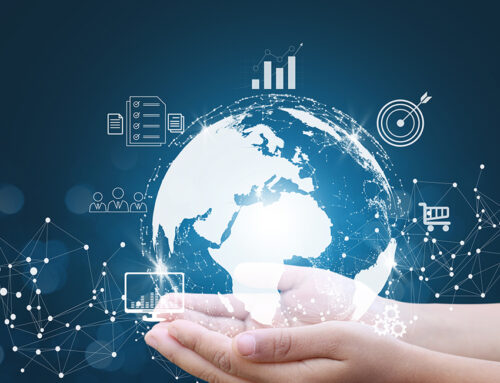15 Things Every Best Food Product Website Must Have
So if you’re a brand manager, product manager, marketing manager or even a web development firm tasked with creating the most amazing website for your company, this is the only article you need to read. Since 2008 we’ve worked with thousands of Food Product Websites from around the globe. We have compiled a list of the top 10 food websites that we recommend including in your campaigns. We’ve seen a wide range of food product websites from highly focused brand microsites to extensive food product websites. That is why we worked hard to find the top 10 food blogs website.
Effective branding is crucial for food product websites, as cohesive branding through colors, logos, and a unified visual identity helps your site stand out and connect with your target audience.
Every week we are asked for our opinion on websites and often asked what’s missing and what can we do better? So it was time for us to combine all of the best ideas together and share them.
Below is a list of different ideas all food product vendors should include for a successful, conversion-friendly website. We’ve tried to provide relevant examples that you can review and add to your own website. A strong aesthetic, including high-quality photography and carefully chosen color schemes, enhances the emotional and sensory appeal of a food website, making it more inviting and memorable.
Introduction
A good food website is more than just a digital recipe box, it’s a vibrant celebration of food culture that invites visitors to explore, discover, and savor the world of good food. The best food websites combine engaging visuals, innovative design, and a thoughtful layout to create an immersive experience that goes beyond simple meal ideas. Whether you’re searching for inspiration, looking to try trending flavors, or hoping to connect with a community of fellow food lovers, a well-crafted website can be your gateway to culinary adventure. In this article, we’ll explore the key elements that make a food website stand out, from intuitive navigation and beautiful collections to the joy of discovering new recipes and stories. Get ready to dive into the essentials of creating a site that not only showcases your brand but also elevates the entire experience of eating, cooking, and sharing food.
1. Product List
First and foremost, it's vital to include a list of all of your food products on your website. Whether you sell snacks, beverages, bakery items, or hundreds of other food products, each one needs to be included on the site. Each product listing should feature the following:
- The product name or title
- A clear image
- A short sentence link to their specific page
- Can be organized by brand or product range
Organizing your products into themed collections, such as seasonal assortments or bestsellers, can enhance browsing and make it easier for customers to find what interests them.
This may seem tedious, but it is necessary and will pay off. Not only does it provide consumers a snapshot of your product range, but showcasing your collection with clear images and descriptions helps attract and engage visitors. People enjoy browsing and researching products online, including food, in large volume. In addition, search engines will benefit from the depth of content.
What Food Brand Does It Well?
We'll look at the top food blogs that highlight what each major food brand does particularly well, and we'll examine how Sanitarium Foods presents its Food Products.
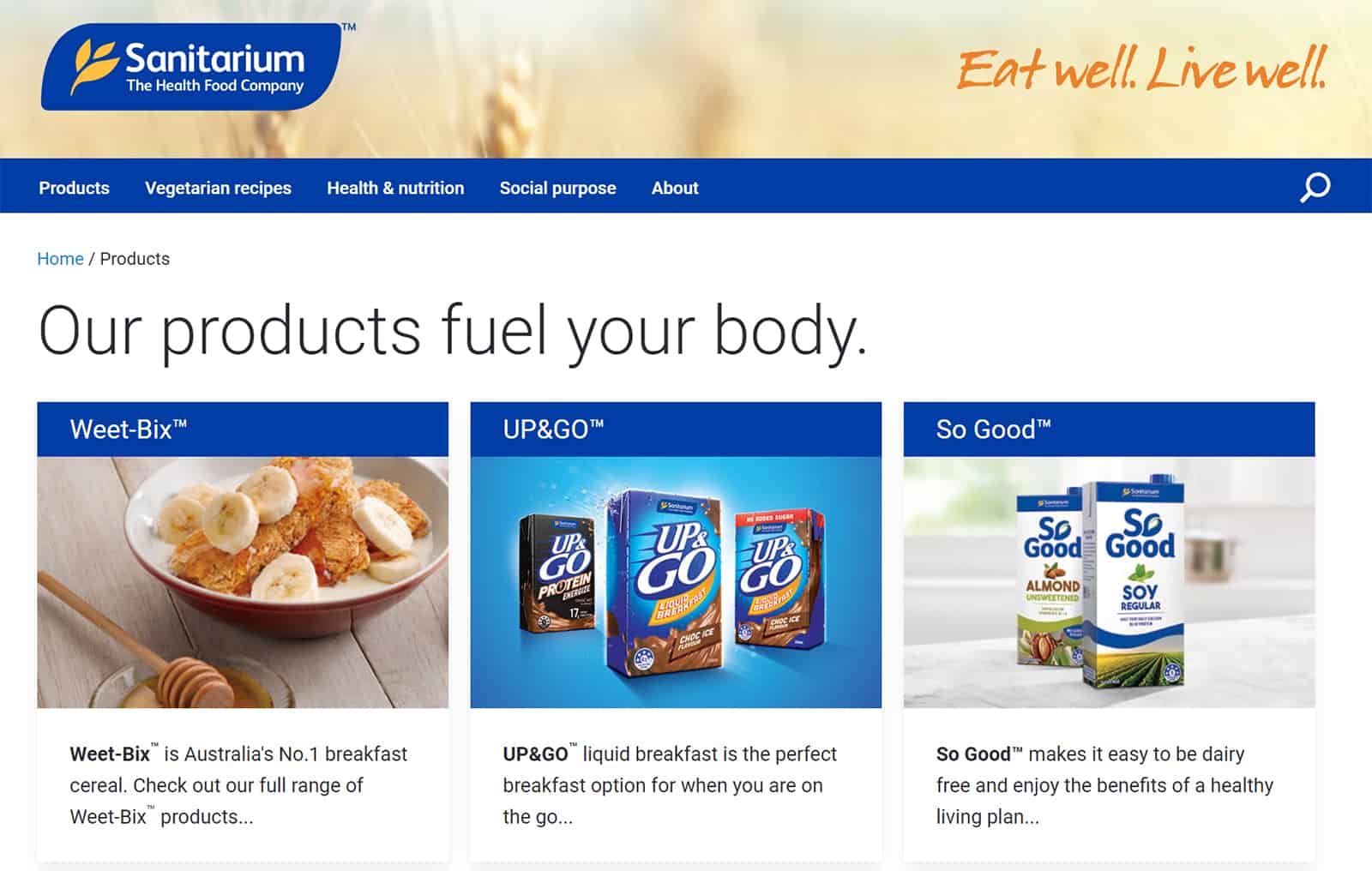
2. Individual Product Pages
Now that your food product list is up, each of your food products should have its own product page. Each food product pages should always include the following:
- A large high definition image of the product
- The SKU Code
- Nutritional Information
- The ingredients list
- The serving size
- Package size or sizes
- A link to recipes that use the product
- A photo of the recipe made with the product
- A section highlighting the benefits of the product, such as health advantages or unique features
If you happen to have a PDF product sheet, include the sheet on this page and make it available for download.
When writing product descriptions, be sure to describe the flavor profile of the product to entice customers and help them understand what makes it unique.
Make sure each URL is keyword rich ie domainname.com/product/name-of-product this will dramatically help in the search engines. A well-designed product page creates a memorable and informative experience for visitors.
What Food Brand Does It Well?
We like the detail of how Barilla Pasta presents their Pasta Products
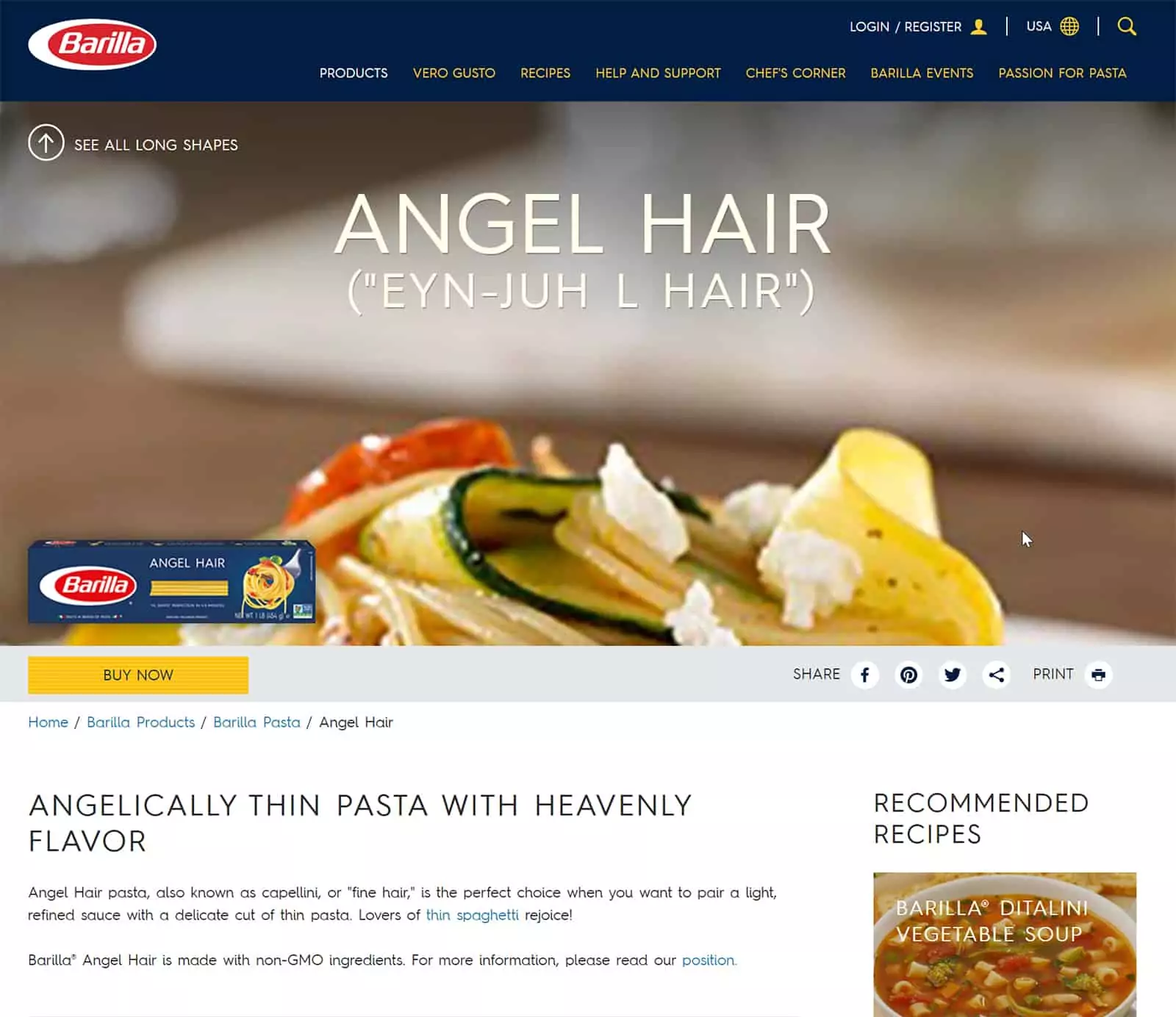
3. Recipes or Recipe Ideas
Recipes are crucial for food product websites. Visitors want to see what they can create with your food products. Featuring recipes from professional chefs can add credibility and inspiration, showcasing culinary expertise and elevating your brand. Due to supply chain disruptions and the increased market share of large food brands. Consumer Package Goods consulting is becoming an important issue. These companies are attempting to improve customer service in order to increase their market share.
Your website should have the main recipe page complete with categories (such as breakfast, lunch, brunch, dessert, dinner, etc.) and a sort by product feature. Recipes can also be tailored for different kitchen setups, from home kitchens to professional environments, making them accessible to a wide audience.
It's also very important to include great, mouth-watering photography for your recipe page. People eat with their eyes first, so it's crucial to include amazing food photography on your website. Don't skip out on this– the imagery matters!
Be sure to include ;
- The top-level Recipe menu at yourdomain.com/recipes
- Recipe Categories (like Breakfast, Cakes, Desserts etc)
- In addition to typical Categories, categorize the Recipes by Product, Product Range or Brand
- Each Recipe Category should have its own URL listing all the recipes in that category
- Each Recipe should have its own URL like yourdomain.com/recipe/recipe-name
- Make sure each recipe needs great photography
- Make sure each recipe includes detailed information, like Ingredients, Method, etc.
- Include cooking tips to help users achieve the best results in their kitchen
- Use videos to demonstrate recipe steps and engage visitors
What Food Brand Does It Well?
We like the detail of how King Arthur Flour presents their Range of Recipes
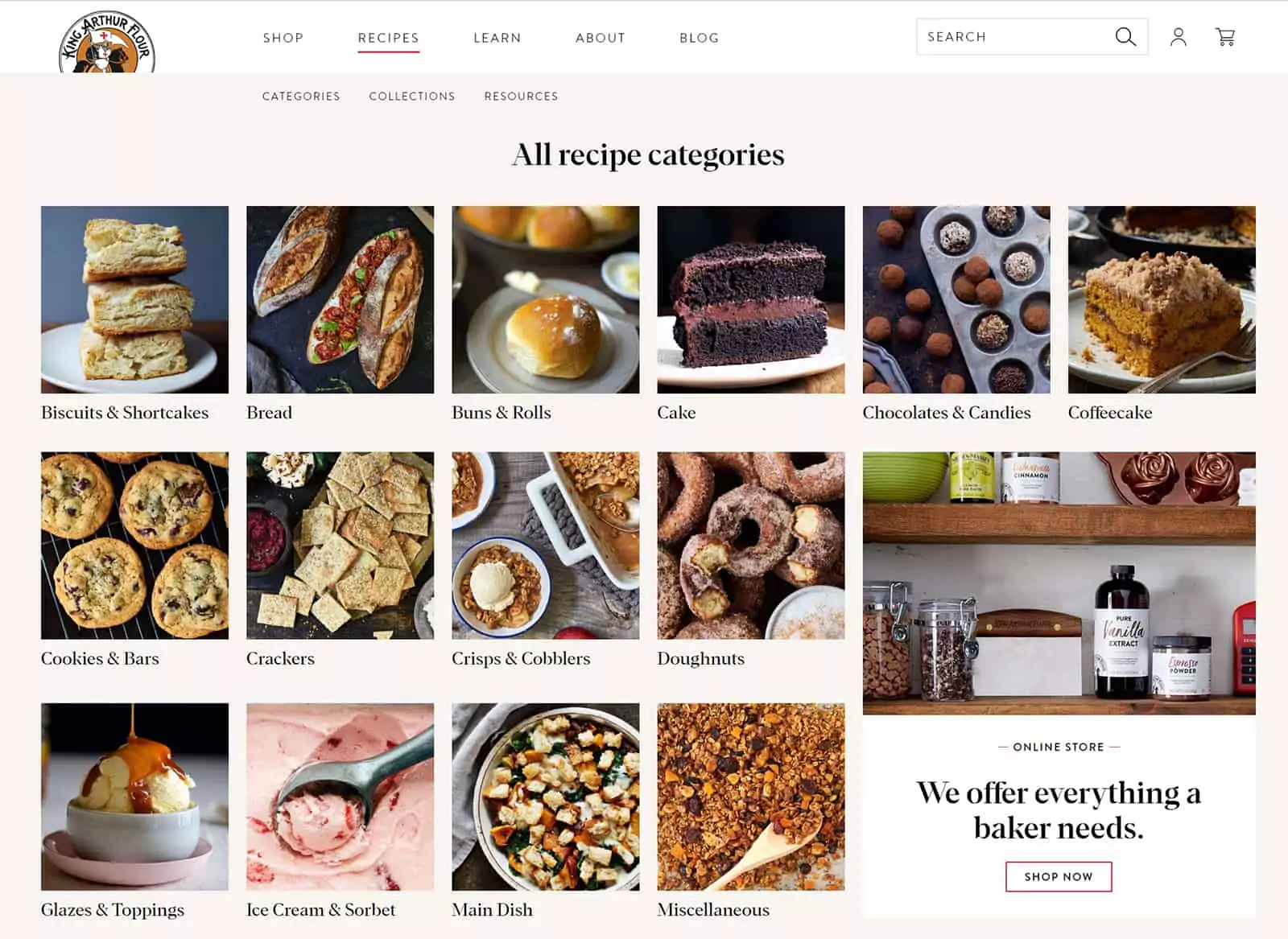
4. Individual Recipe Page
No matter the cooking experience of the consumer, everyone loves to be inspired by a recipe and it's always easier to show how to use a food product if the recipe is clear, and photos look amazing. Recipe pages should also highlight the taste and sensory experience of the dish, helping users imagine the flavors and enjoyment they can expect.
Your recipe pages are a great location to also feature any partnerships with a celebrity chef who can showcase your food products. The celebrity chef could create the recipe and inspire potential customers and promote the product to their fan base. A video for each recipe is also highly recommended, as they can help consumers learn how to properly use your product.
Be sure to include;
- A URL for each of your food product recipes eg, yourdomain.com/recipe/recipe-name
- Great photography for each recipe and where possible include an image of the food product used in the recipe
- Consider adding a video for every recipe
- Make sure each recipe includes detailed information, like Ingredients, Method, etc. And ensure the proper measurements (metric and imperial if you are a global brand) depending on where your market is.
- Hyperlink in the Ingredient list to the Food Product featured in the recipe
- Use a light and clean visual style for recipe pages to make them more inviting
Including videos or chef endorsements can elevate the overall recipe experience, making your content more engaging and memorable for users.
What Food Brand Does It Well?
We like the detail of how Beyond Meat presents their recipes
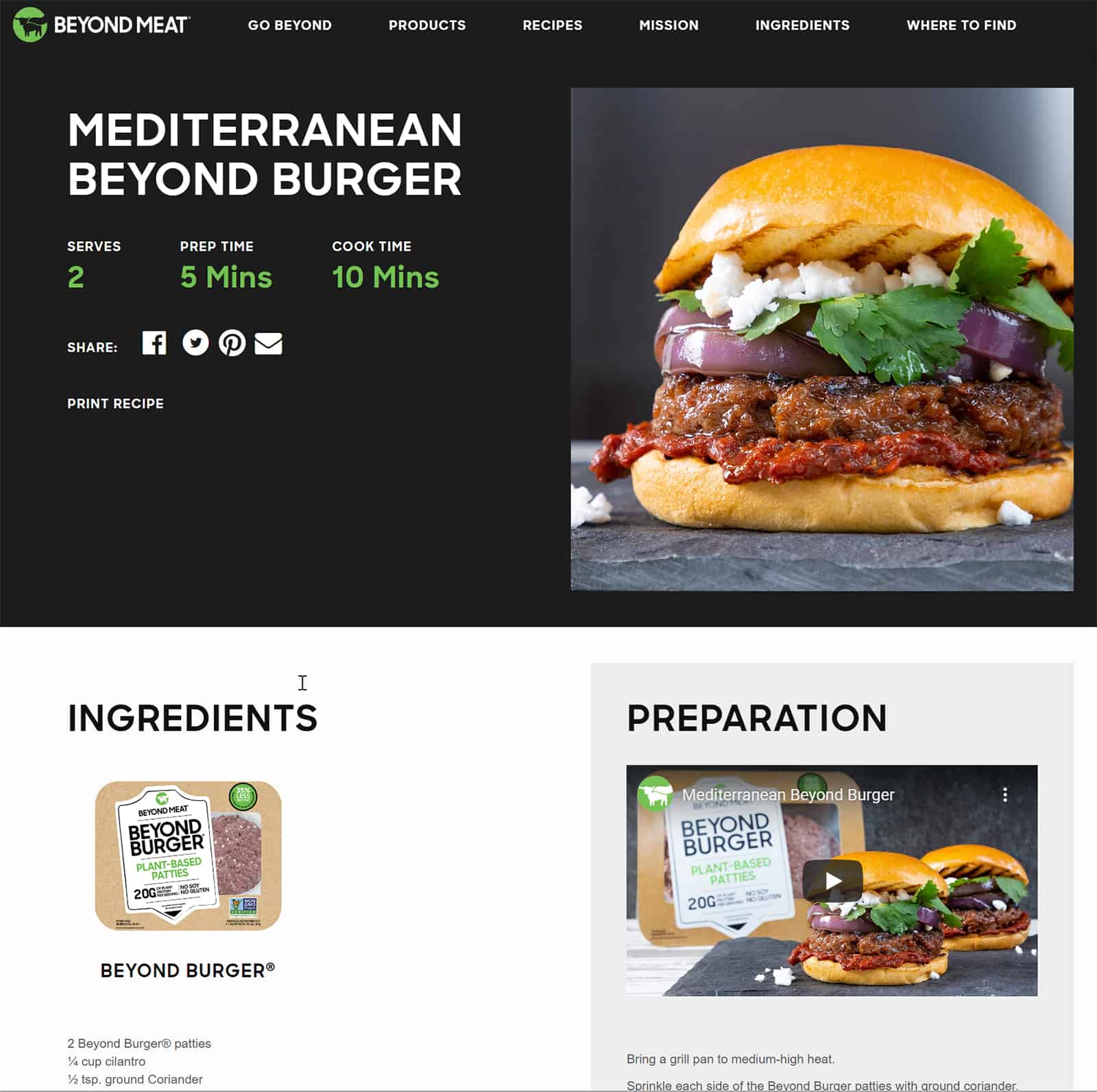
5. Where to Buy
Now you’ve inspired consumers to buy your product, you need to help drive them to purchase. The focus should be on providing clear and accessible purchasing options for all customers. There are two trains of thought here, one is a basic approach and the other a detailed approach.
Where to Buy – Basic
The basic approach is to simply provide a list of major retailers (Bricks & Mortar Retailers as well as Online Retailers). This should be the bare minimum a food brand should take. Always include a logo that links to a major retailer or supermarket that carries your product. For online retailers, simply link to your Brand Page on your online retailer – its essential to make it easy for consumers to purchase then and there.
Where to Buy – Detailed
The detailed approach is to provide detailed information on where to buy either online or nearby. You can even go to the next level and do it via Product ie where can you buy this exact product nearby and provide directions. We’ve seen brand go to immense detail to even show stock levels at the nearby retailer. If you operate a global brand, make sure to include a sort by country or region function. It is important to list store locations so customers can easily find products available near them, making the purchasing process more convenient and tailored to their needs.
What Food Brand Does It Well?
We like the detailed approach of how Spam shows consumers exactly where they can buy and what products are in stock and or buy directly from their page.

6. About the Company / Story / Background
People want to know about your company. How did it start? What’s the story? What sets your business apart from the rest? Are you doing good for the environment or have good ethics? Some brands focus on enhancing the quality of life through their food philosophy, aiming to inspire a life well-lived and joyful experiences.
Today’s consumer cares about these things more than ever. Include a story page that talks about the history of your company, how it started, product development, endorsements, partnerships, sponsorships, how your product is sustainable, and more. If your brand has a luxury positioning, highlight your premium story and exclusive experiences to appeal to discerning customers. For brands with a rustic aesthetic, emphasize authenticity, traditional values, and a handcrafted approach to connect with those seeking genuine, earthy experiences.
What Food Brand Does It Well?
We like how Egglands Best communicates to consumers their story.
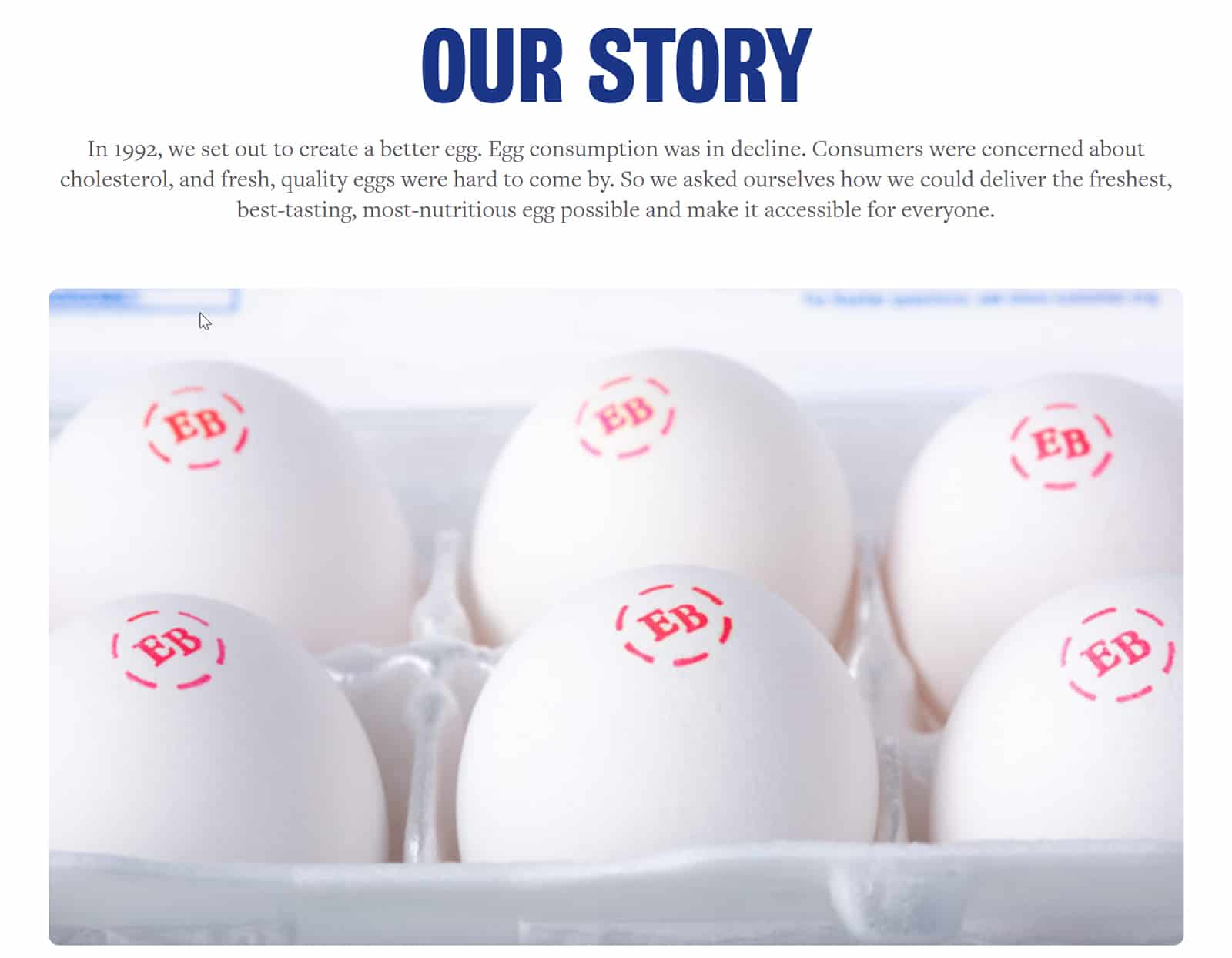
7. Don't Forget Mobile Experience
There is no question that consumers navigate to websites on desktops and laptops when family meal planning at home. As such most websites are designed to maximize that approach in communicating with grocery buyers. But it's important for Food Product companies to also make sure their website is designed with Mobile in mind (including tablets and iPads) as many consumers read recipes and write shopping lists on their smartphone or tablet. Designing a mobile experience is especially important as many consumers will interact with your website in the supermarket aisle or even point of sale. Innovative mobile features, such as responsive design and mobile-specific tools, can greatly improve user experience and set your site apart. A great mobile site combines intuitive navigation with engaging visuals for a seamless experience. So, making sure consumers can get nutritional information, ingredients, recipe ideas or even downloadable coupons in a mobile experience is important. Questions to ask… how does the navigation work vertically and horizontally?
What Food Brand Does It Well?
We like the Sara Lee mobile site best as it communicates to consumers consistently across both Mobile and Desktop experiences.
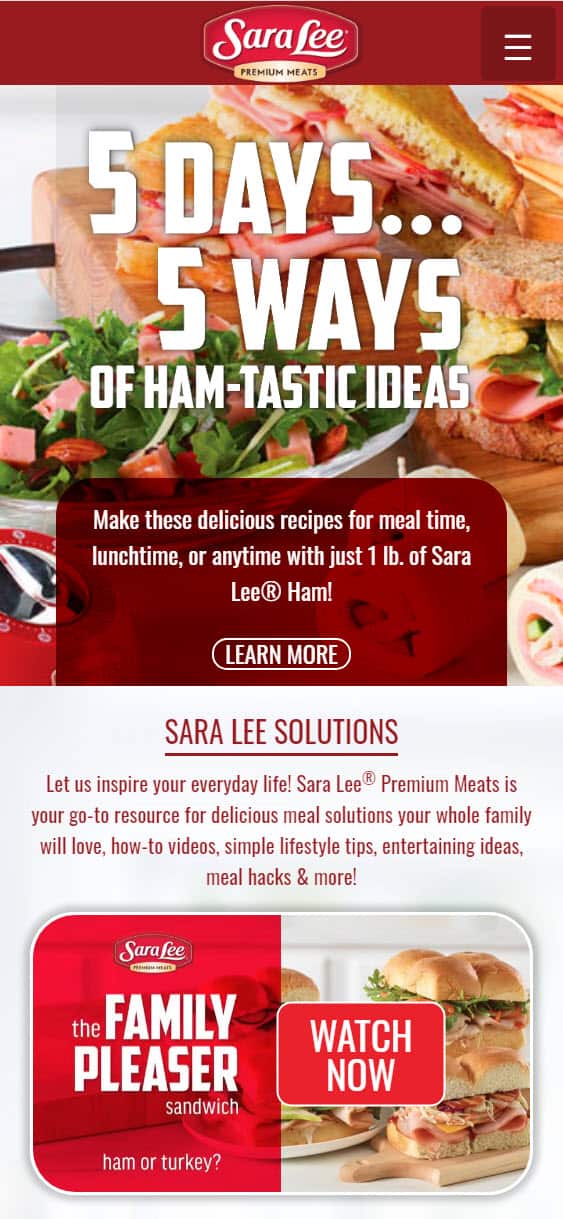
8. Email Newsletter
Every food brand wants to build their email newsletter list. Having this First-Party Opt-In Data is important from regular communication through to new product launches or competitions etc. You will need calls to action around the website to support this. Encourage visitors to subscribe to your newsletter for updates, recipes, and exclusive offers.
To drive subscriptions there are a few important things to consider.
a) No consumer will sign up to a newsletter for no reason. Some ideas to encourage consumers to sign up could be auto-enrolment after entering competitions, emailed coupons, free samples, new products etc. Give consumers a real incentive.
b) Make the sign-up process easy. Don’t ask for data points you don’t need. I’ve always wondered why a food brand needs date of birth. Could you do the sign up via a social network like Google, Facebook or similar? Keep it simple. Too many fields will slow the sign up rate and may deter consumers from completing the form.
c) With your newsletter, its key to have a dedicated subscription page for email newsletters such as domainname.com/newsletter where visitors can sign up. When they are successfully signed up, they should be taken to a success page such as domainname.com/newsletter/success. By having a dedicated sign up page and success page you can easily measure the conversion rate.
What Food Brand Does It Well?
We like Perdue’s fun sign up process of sending Savings to your email.
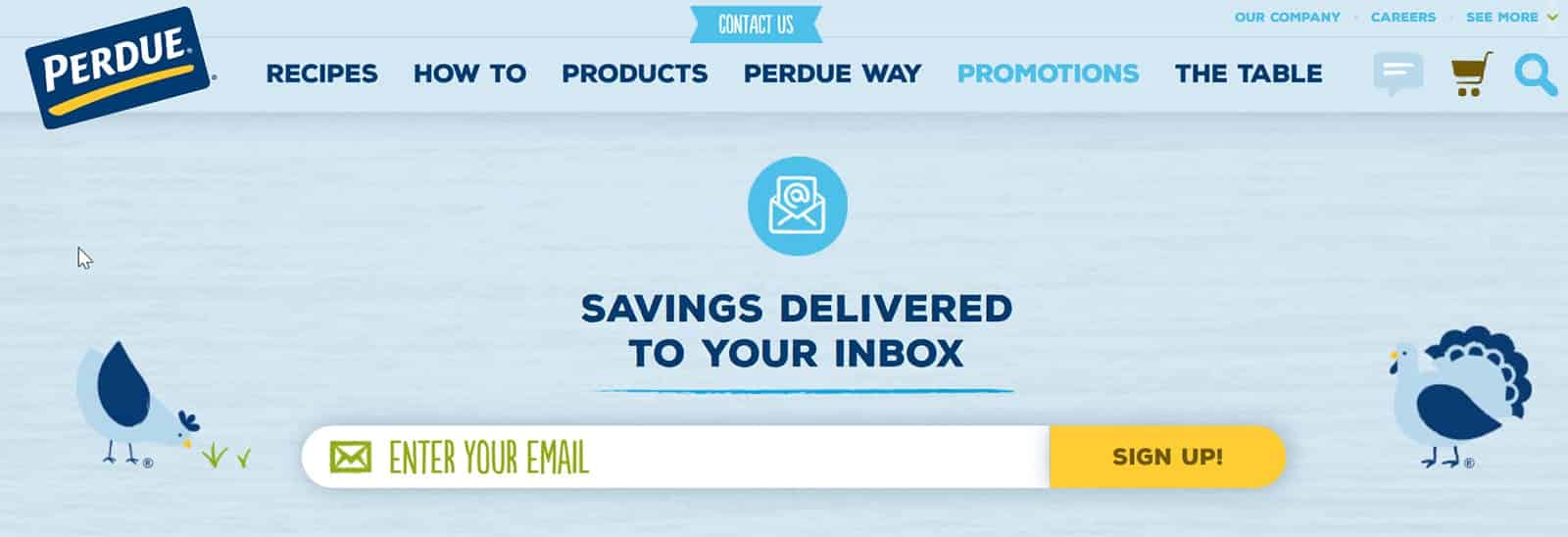
9. Food Service Pages
Many food brands nowadays have Food Service sized versions of their products. These typically come in larger packaging and are sold for the catering and restaurant industry. If you sell to the Food Service industry, make sure that you either include a Food Service Page on your website or alternatively have a dedicated Food Service website. A dedicated Food Service page focuses on the unique needs of restaurants, cafes, and hospitality clients.
Content to publish on your Food Services pages should include;
- Food Service Products (Schools, Healthcare, Convenience Stores, Restaurants and Hospitality)
- Food Service Contacts
- Food Service Distributors
- Food Service Recipe Ideas
What Food Brand Does It Well?
We like how Chobani Foods has built a dedicated Food Service Website for Restaurants, Cafes and other Food Services establishments.
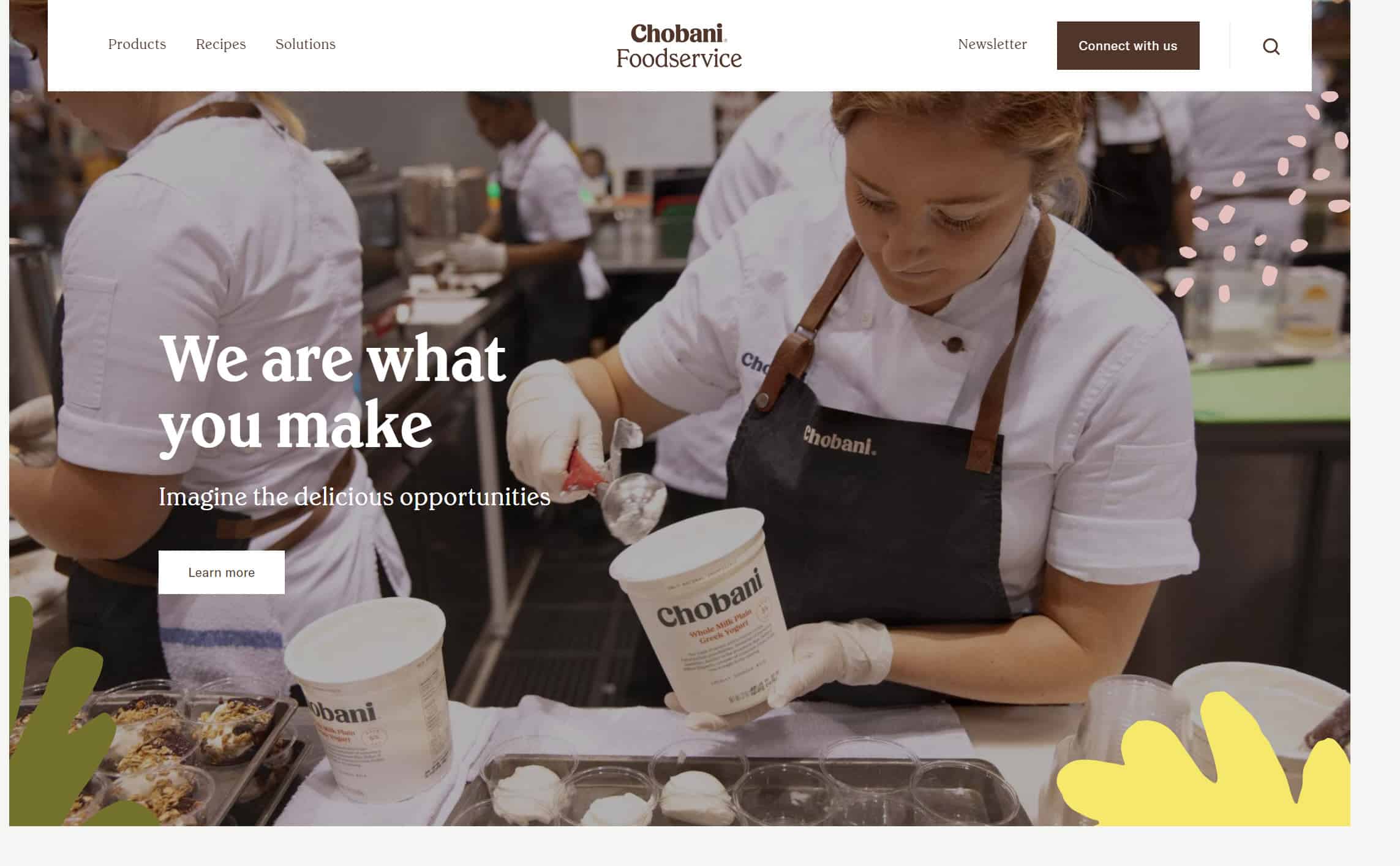
10. Wholesale
Wholesale is slightly different from Food Service. Wholesale is a large sector for many food companies. In our research its one area that seems to be neglected on many food Product Websites. Your Wholesale page should include ;
- Downloadable Catalogs and Brochures
- Custom Solutions for Wholesale Clients
- Unique Product Blends
- White Label Products
- Wholesale Contact Details
What Food Brand Does It Well?
We like how Hodgson Mill has a dedicated Wholesale Page and how they drive interest via a series of PDF downloads.
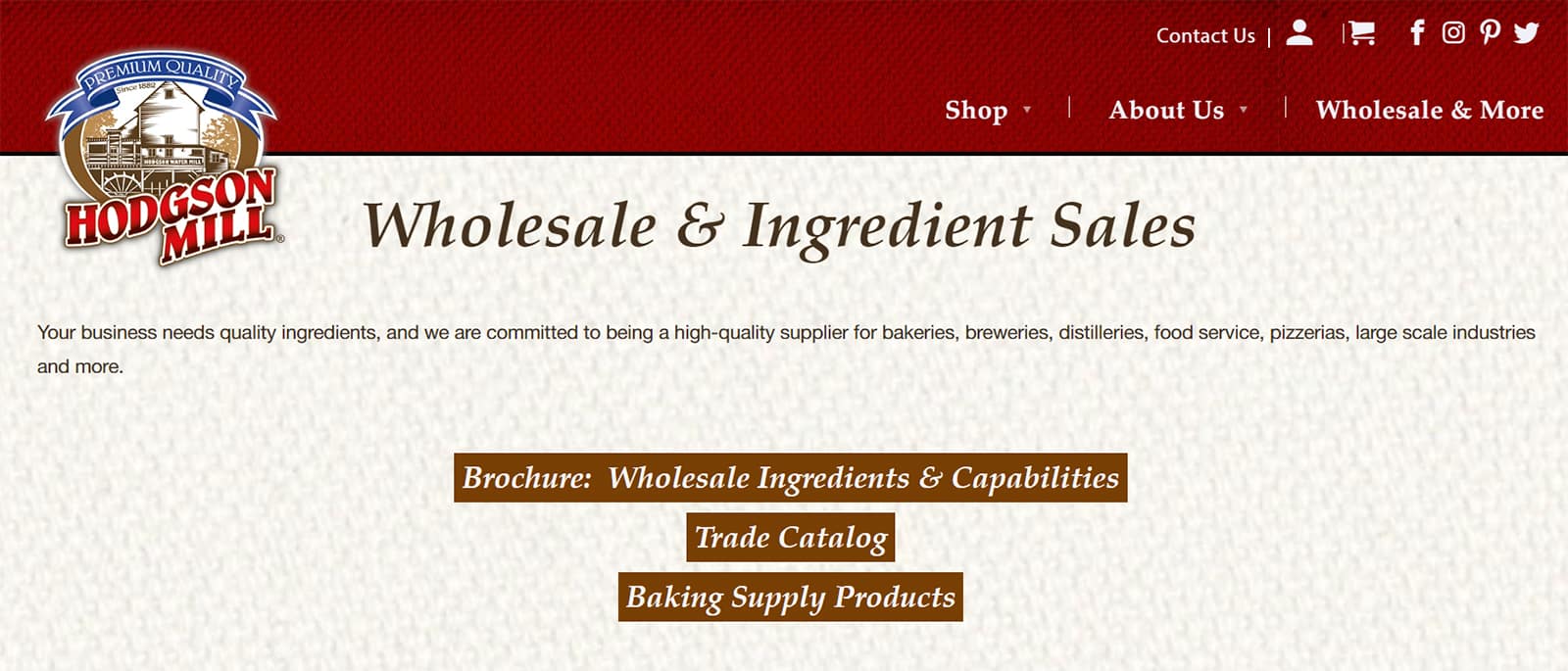
11. Online Ordering
More and more Food Product brands are beginning to sell their products directly from their website only. This is a great approach to take since the business will be able to reap the rewards of getting the full consumer margin. Having a connection directly to the consumer is a growing trend with many companies in the food sector.
Apart from the eCommerce platform management and managing fulfillment and delivery of products its advisable to;
- Make the E-commerce process as easy as possible
- Keep it on the same website/domain name
- Consider offering Free Delivery
- Consider offering Free Samples with each order
- Can you use Promotional Codes / Discount Codes?
- How could you differentiate your online product to add more value to consumers?
An important thing to consider here is pricing. You don’t want to undercut your existing distribution network of supermarkets and grocery stores. So, try and stick to using Recommend Retail Pricing or RRP.
What Food Brand Does It Well?
We like how Unilever’s Maille Mustards offer consumers “Gifts” opposed to going head to head with their regular “supermarket” product range. One their Online store they have created a more luxurious range of Mustards that are unique to their online store with different packaging, different flavors and Limited Editions.
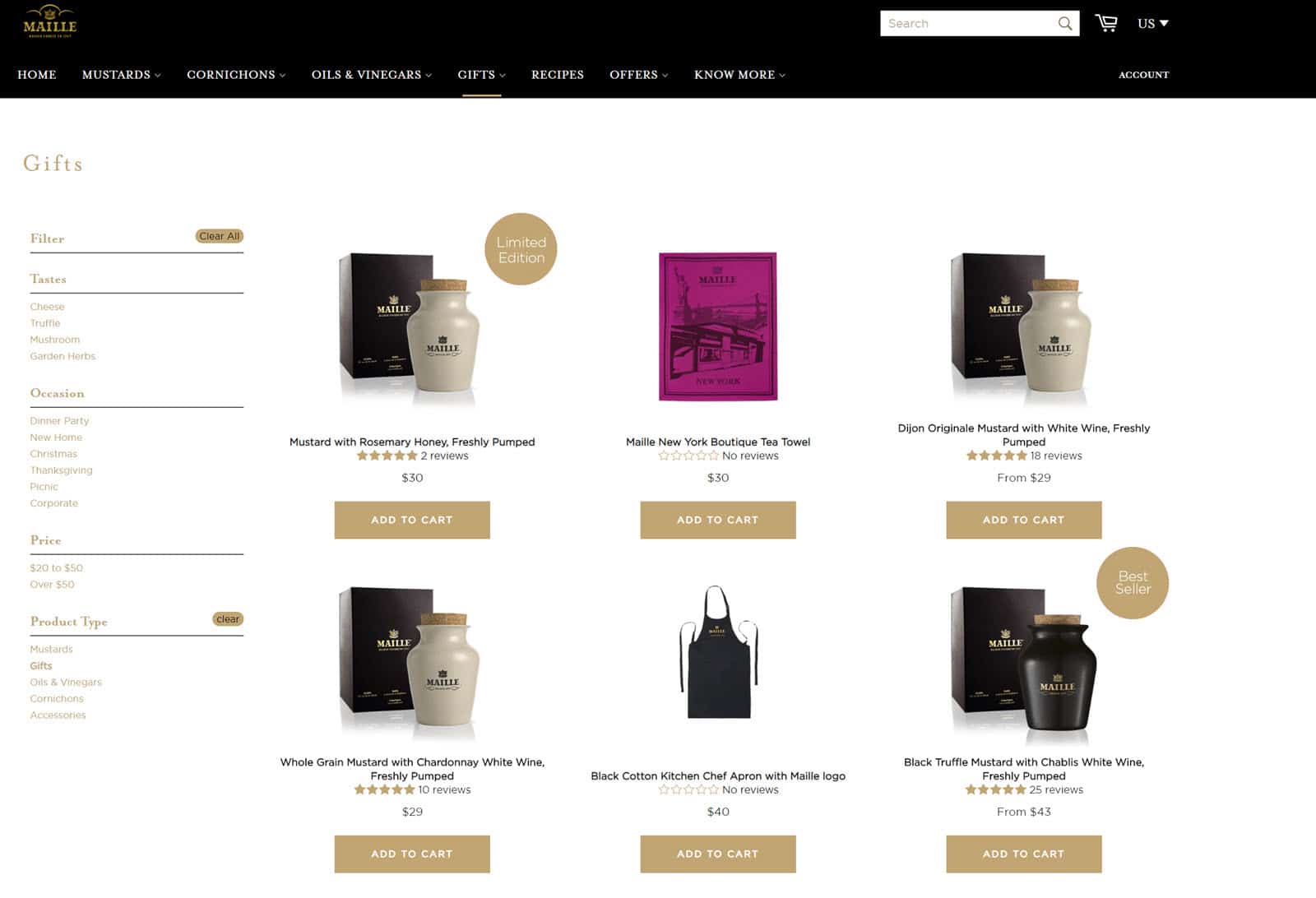
12. Blog
Every food brand website should have a blog. Blogs help give a food brand a real identity and help consumers understand or familiarize themselves with the brand. For this, you must have an idea about “What is A/B testing?”
A blog is ideal for creating interesting content, such as recipes, food stories, marketing partnerships, food bloggers that are using their product etc. You can also add stories or news to the blog too. The ideas are endless. Consider including personal stories, such as a mom sharing her journey with food and family, to create an emotional connection with readers. Blog posts about baking pastries or sharing unique pastry recipes can showcase your culinary expertise and attract food enthusiasts. Incorporating videos in your blog posts to demonstrate recipes or provide behind-the-scenes content can further engage your audience and make your website more dynamic.
Blog posts can then be used for marketing online as well as used to populate social networking sites with relevant content that can be used to “drive” people back to the website.
What Food Brand Does It Well?
Not really a Food Brand as such, but we like the blog by Starbucks called Starbucks Stories which covers a wide range of news about the Starbucks brand.
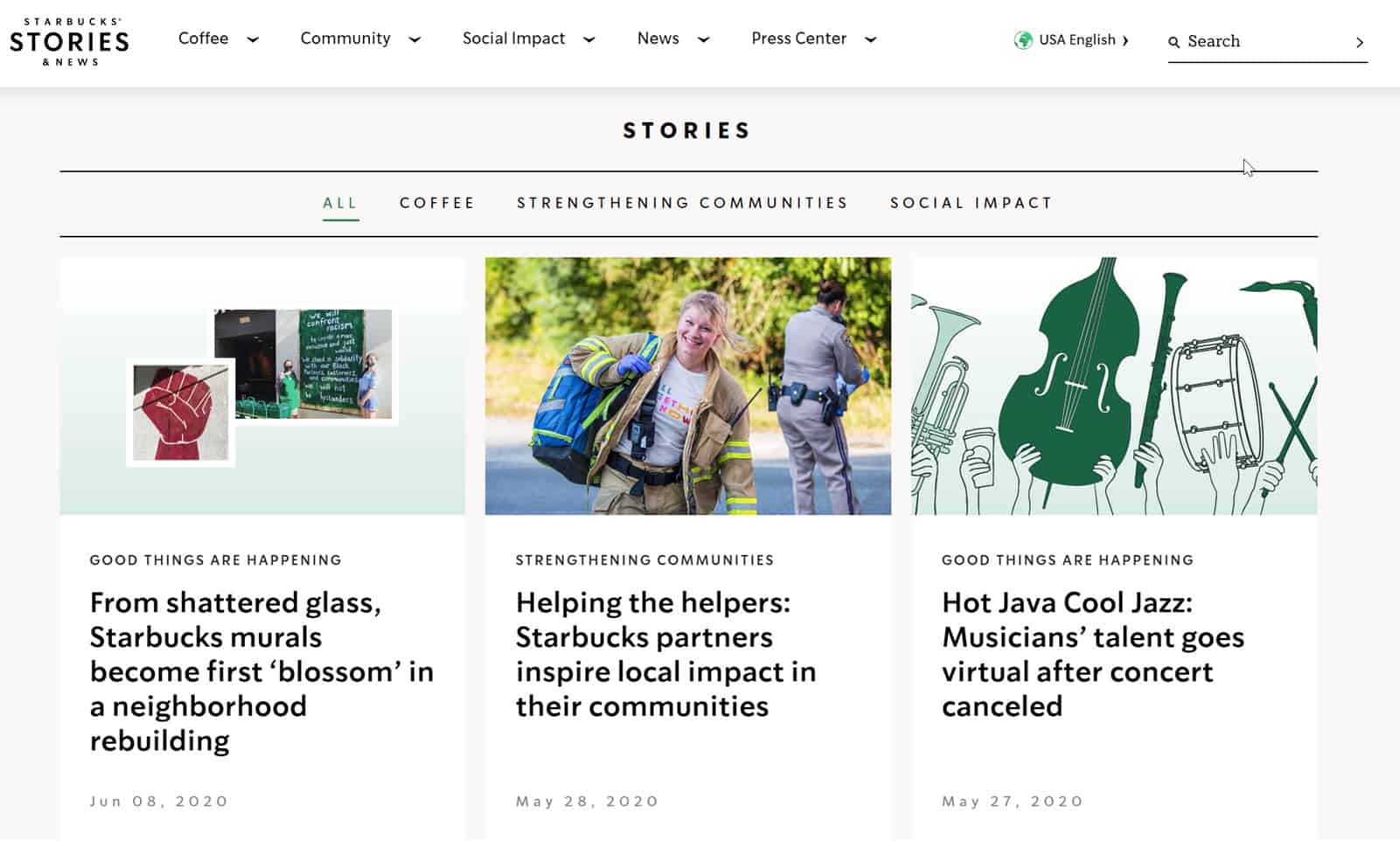
13. Social Networking Page
A simple social networking page is a simple, logo-packed page that links to all of your brand’s social media accounts such as Facebook, Twitter, Linkedin, Instagram, TikTok, Snapchat etc. Be sure to include all of your accounts and when setting up the links, make sure they “Open in a New Page” so they don’t take people away from your website.
This is very useful for marketing initiatives and also provides an easy spot for your fans to quickly follow you online on their preferred Social Networking platform. It’s also easy to share this link on Social Networking. You can also simply add Social Network logos to the footer of your site.
What Food Brand Does It Well?
We like how the Food Brand, Trident Seafoods has added Social Networking Widgets on their website, making it easy to connect or engage with them.
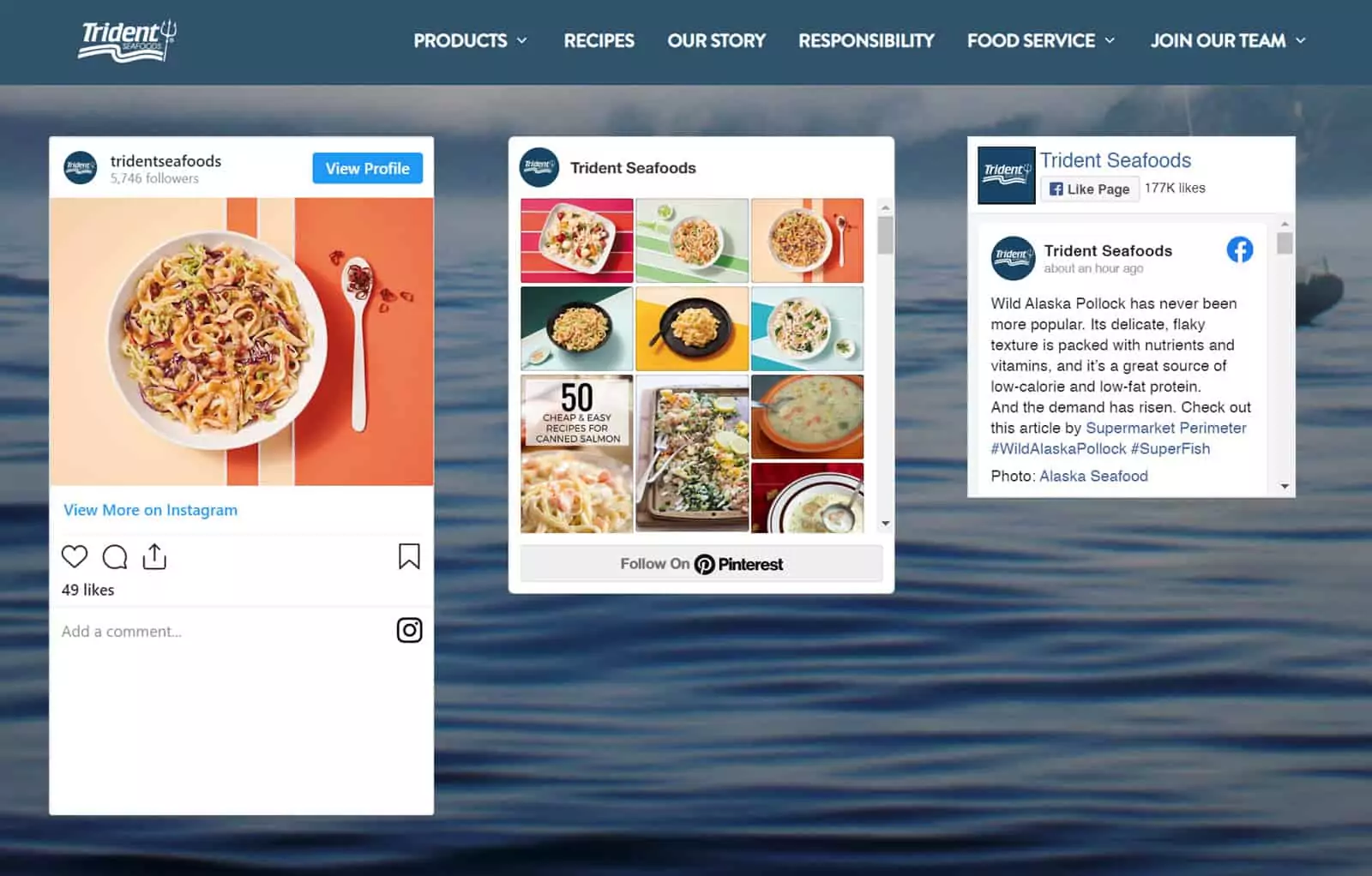
14. Contact Us
A Contact Us page is essential for any food brand’s website. There are various reasons why people will need to contact you and making it easy will go a long way with your customers. There are of course consumers seeking customer support, helping wholesale buyers get in touch, and don’t forget, a way for media or journalists to get ahold of your company.
It can be a very simple page, but we recommend the following at a minimum;
- Email Address or Contact Form (or both)
- Phone Number (that goes to a person, not an answering machine)
- Headquarters Postal Address (yes some people still send mail)
- Preferred Social Network (ie Facebook Page or Messenger)
Finally, it’s not just about having a contact us page with a raft of options. Its also about setting expectations on when customers can expect a reply. Ensure you have a business goal of replying to your customers or potential customers within a set time frame eg 1 business day.
What Food Brand Does It Well?
We like how the Hidden Valley gives consumers a wide choice of ways to contact them.
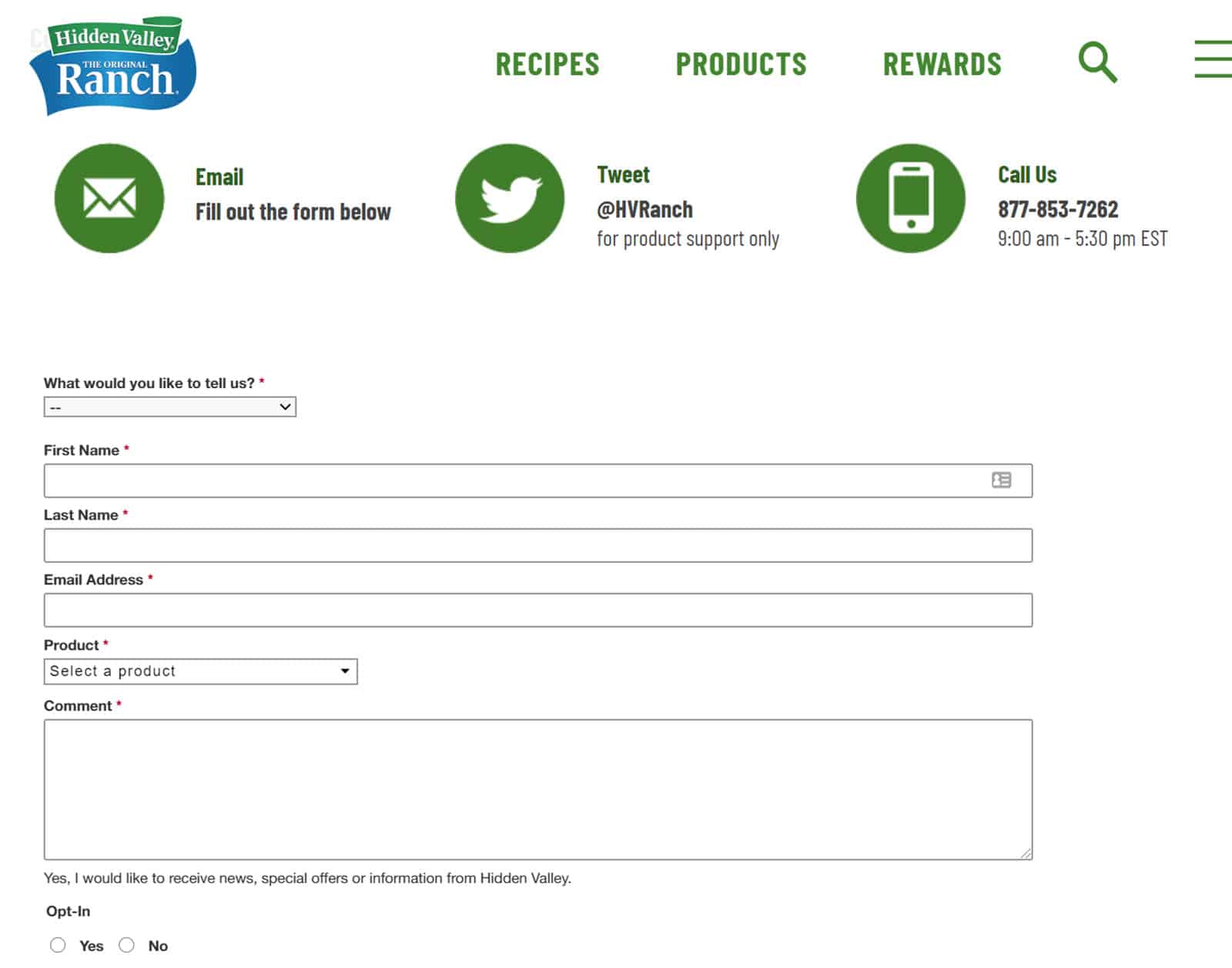
15. Tracking Visitors
Irrespective of the above items that you’ve included in your food brand’s website one thing that’s essential is installing some sort of User Tracking. This will allow you to understand where people are coming from, what they are looking at and how long they stay.
Many companies use Google Analytics free version, but there is an enterprise version as well called Google Analytics 360. Other products include Adobe Analytics, Heap, and Matomo to name a few. You should be able to set up custom tracking for your advertising campaigns to measure the success of the campaign.
Irrespective of the platform you use, you should set goals around tracking such as;
- Number of visitors per month via source
- Pages per visit
- Avg time per Session
- Conversion Rate (if applicable)
- Avg Bounce Rate
- Number of New Sessions
There also specialty tracking platforms like Optimizely that helps you optimize and A/B test pages. There is Mouseflow or Hotjar that allows you to watch sessions of users as they navigate your site.





